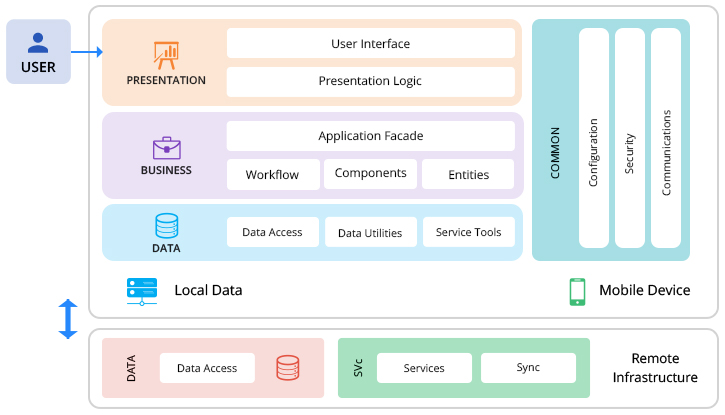By 2021, global app downloads are anticipated to spike to 352 billion. Mobile apps are habitual for most people, but very few are aware of the architecture in place underneath the surface of their favorite applications. At Clearbridge Mobile, our Mobile Architects contribute to a highly collaborative, team-oriented environment and occupy an important role as mentors of the mobile app development team.
If you’re just entering this blog series, we’ve already profiled a typical day for Project Managers, QA Analysts, and UX/UI Designers. This installment will highlight the role of Mobile Architect, Roberto Galeano, and the importance of app architecture for delivering fully structured mobile solutions.
What is Mobile App Architecture?
Mobile app architecture encompasses the techniques and practices necessary for building fully functional mobile apps. These techniques are composed in agreement with industry standards and client requirements. Well-structured mobile app architecture helps increase maintainability and expandability which limits the business risks involved with app development.
Mobile app architecture is designed in three main layers within an application.
Source: Peerbits
Presentation Layer – The presentation layer contains the user interface (UI) components and UI process components. At a high level, this layer defines the app’s presentation logic and how the product will look in the hands of its users.
Business Layer – This layer focuses on how to demonstrate the business identity to the user. The business layer is comprised of workflows, business entities, and components.
Data Layer – The data layer houses data-related components including access components, helpers, and utilities, as well as service agents.
So, what exactly does a Mobile App Architect do?
Roberto: If you find out, let me know.
(Jokes aside). Creating mobile app architecture involves selecting multiple structural elements within a mobile app and its interfaces. One aspect is creating backend database design. The backend is a critical piece of app development because that’s where the value is. An app in itself is nothing if it doesn’t manipulate the right data in a timely fashion.
I am responsible for creating a technical solution from end-to-end. I translate the client’s vision into a functional and practical framework for their mobile app. I make sure the things we do in development meet certain standards and follow best practices to ensure expandability. We don’t want to rework our progress as we add features and the app matures.
I look for opportunities to improve reusability and leverage what’s worked for us in the past. Knowledge transfer is a big part of my job.
Why is Mobile App Architecture Important in Development?
The value of a sound architecture is evident in many ways. Essentially, mobile app architecture keeps the development process running smoothly and efficiently.
Architecture Supports Communication
Think of mobile app architecture as a blueprint for the entire mobile app system. Architecture is indispensable for the understanding, negotiation, and communication between all stakeholders. A clear plan for how the entire system will work simplifies the decision-making process.
Deliver High Quality at Lower Cost
Mobile app architecture is built to change. A secure architecture is built to support the evolving needs of a mobile app optimally. Overlooking mobile app architecture can cause additional requirements and damage the entire structure of the application resulting in a redesign to accommodate the additional scope and when project scope increases so does the timeline and price tag. When you’re developing a new mobile app, you need to consider long-term value over short-term cost and effort.
Plans for Code Reuse
Developing identical features more than once is costly and wasteful. On the other hand, reusing code speeds up your time-to-market and decreases the risk of unwanted behavior and failures since testing the reused code and libraries is complete. A stable architecture creates an efficient and consistent development lifecycle by accounting for which components can be reused between projects.
Recommended: The 8 Wastes in Mobile App Development and How to Avoid Them
While mobile app architecture is invisible to end users, it’s one of the most important aspects of app development. Here’s what Roberto Galeano has to say about working as a Mobile App Architect at Clearbridge Mobile.
What does a typical day look like for you?
Roberto: No two days are the same, literally. I’m typically involved in multiple projects at the same time and my day depends on what stage of the project I’m in.
My day also depends on which project team I’m working with. Not every team member is working at the same skill level between teams. We work with different platforms – Android, iOS, Xamarin – and sometimes one team is stronger on a particular platform compared to others. Situations like this require extra coaching on my part to make sure one platform doesn’t fall behind.
What’s the hardest part of your job?
Roberto: Managing expectations and balancing a client’s feature requests with what’s feasible for development. But, this is why we have an architecture in place. We build to accommodate change; regardless, it can be difficult at times to explain why particular features aren’t achievable in a certain timeframe. The key is to keep everyone focused on developing only the requirements necessary for releasing a functional minimum viable product.
What’s your favorite part of your job?
Roberto: I have to say the brightest part of my day is my team and the different people that make up each team.
A Mobile Architect is a Developer who has failed many, many times and it’s important to know that failure is not the opposite of success – it’s a part of it. An important part of this role is acting as a mentor for your team. I get the chance to learn and teach. Each interaction is very valuable to me.
What type of person makes a great Mobile Architect?
Roberto: A great Mobile Architect is someone with enough experience and is generous when it comes to sharing their knowledge. In this role, you can’t be afraid to push yourself out of your comfort zone and make mistakes. A Mobile Architect is always looking for an opportunity to learn. You can always learn from everyone.
Final Word
Designing mobile app architecture is the first and crucial step in app development. Architecture not only makes your product secure but it also supports scalability as your app evolves. While it’s important to meet increasing design expectations, overlooking architecture can cause even the most well-designed mobile apps to fall short of success in the app market.
Don’t underinvest in mobile app architecture. Start a conversation with Clearbridge Mobile, today.







